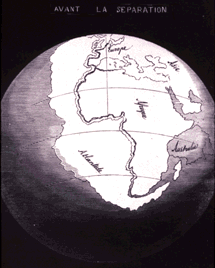REVISED Monday, October 29, 9 a.m.
MONDAY MORNING NOTE: We have updated this post about twice each day since last Thursday, in order to document the changing forecasts of Hurricane Sandy. As of Monday morning, the storm has not yet made landfall, and its exact path remains uncertain and very unusual as it interacts with other storms. The National Hurricane Center cautions that the exact location of the center is not very important as this is a very wide and slow storm, with the highest winds not necessarily near the center.
The cones are revised as geographers and meteorologists learn more about the behavior of each storm over time. Compare the forecast cone from Thursday afternoon ...
with the cone generated Friday morning ...
and with this cone Friday evening:
By Sunday morning, the possible ranges of Sandy's path had narrowed, and it had become apparent that it will turn northward after weakening near the center of Pennsylvania. It is also likely to maintain tropical-storm strength into Friday, a bit longer than had been expected.
As of Sunday evening, the storm had moved northward, and its path was expected to turn further toward the east, with the possibility of turning directly into New England late in the week.
By Monday morning, the northern portion of the storm was affecting Massacusetts, though the center was still hundreds of miles to the south. The storm was expected to slow even further, tracking somewhere into northern New England or southeastern Canada in the early hours of Saturday.
These and other graphics generated by the National Hurricane Center are created with the use of very strong geographic and cartographic skills. For example, the following map indicates the expected probability of winds at tropical-storm strength being observed at some time during a 120-hour period. Similar maps can be viewed for expected precipitation.
In turn, information from the NHC is combined with other kinds of geographic information as people in many kinds of organizations make geographic decisions as they prepare for the storm. Retail companies such as grocery and hardware stores are making important decisions about the trucks that are moving from all over the United States toward the areas that are expected to be affected. How much material should they send? Where should they send it? When? Are there safe places near the storm where supplies should be sent temporarily? All of these are complex, geographic questions with very important consequences.




















